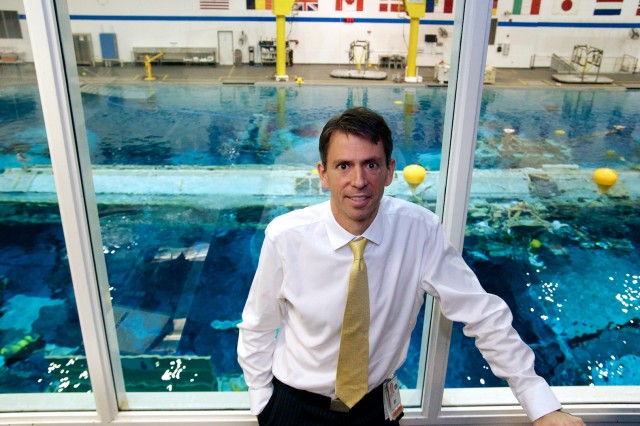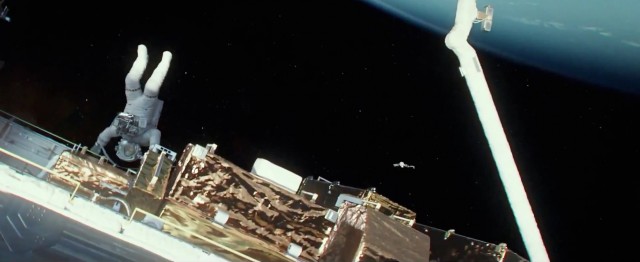We sit down with the guy who trains spacewalkers to see what's right—and wrong.
I haven't seen Alfonso Cuarón's Gravity yet, but I want to. The movie will enter general release here in the US on October 4. It stars George Clooney and Sandra Bullock as two astronauts having what looks to be a really, really bad day in space. Trailers for the movie show them flying around in their space suits, yelling and crying and dodging debris from exploding satellites and space ships and space stations, all lit by a beautifully rendered and untouchably distant Earth in the background.
The director and the studio have taken great pains to recreate the experience of operating in microgravity as accurately as possible. Cuarón consulted with NASA astronauts on the particulars of moving in microgravity and, according to the NY Daily News, the movie's production designers studied thousands of NASA photographs in order to make their vision of space look authentic.
When asked how far that commitment to verisimilitude stretched, though, Cuarón said that while the movie strives for accuracy, "it would be disingenuous to say we did it 100 percent, because this is a movie, and we needed to take certain liberties."
The five minute-plus extended trailer for Gravity. Keep this video handy, because we're going to give it the MST3k treatment in just a moment.
There was a five-minute "extended trailer" for the movie published last month. It certainly had some gripping visuals, but the longer it went on, the deeper my frown became. I don't claim to be an expert, but the stuff that George Clooney and Sandra Bullock were doing on the screen just didn't look right. Certainly cool, but not right.
But this is Ars, and on certain things, we have the hook up. I may not be the expert, but I knew someone who was, and I was going to ask for his official opinion on that extended trailer.
The man who makes the plan
The last time I talked with Zeb Scoville was at NASA's Neutral Buoyancy Lab, the enormous indoor pool where NASA trains its astronauts on how to spacewalk—or, more properly, how to function during extravehicular activity, or EVA. Scoville is the EVA task group lead at the NBL, and he is responsible for managing the teams that figure out how EVAs work. If an EVA's goal is to replace a part outside the space station, for example, Scoville figures out exactly what the astronauts need to do to replace the part, including the physical movements they need to make. His team is made up of actual NASA flight controllers—during training at the pool, they run the simulations, and during the actual missions, they're manning the consoles in Mission Control.

NASA EVA Task Group manager Zeb Scoville, standing in one of the test coordinator control rooms at the Neutral Buoyancy Laboratory. Visible behind him is the NBL pool.
Steven Michael
If anyone could shed some light on the accuracy or inaccuracy of Clooney and Bullock's space antics, I figured Scoville would be the man. After a quick call to NASA's press office to arrange some time to talk, we sat down together to watch our way through the trailer.
Problem: debris
The trailer kicks off with an EVA in progress, and a radio-distorted voice is heard calling for an abort. It becomes clear that the message is directed at some astronauts working on something outside their spacecraft. It looks like they're repairing the Hubble Space Telescope, though it might be something else—for instance, some KEYHOLE reconnaissance satellites are said to share the Hubble's external form factor. Whatever it is, the astronauts are outside with big debris incoming, which means they're in trouble.

Screencap from the trailer, showing the start of a giant debris storm. Note the monstrous size of the piece of debris near frame center.
Warner Bros
Right away, the sheer size of the debris gave us pause. NASA relies on US Strategic Command's big radars to keep constant radar watch on its vehicles, and the chunks shown on-screen are far larger than the minimum size that USSTRATCOM would notice. "Part of the procedure for getting ready for an EVA would include checking for debris like this, wouldn't it?" I asked.
"Right—we have a process that's known as a 'certification of EVA readiness,'" answered Scoville. "We have the EVA community come together and they'll present a lot of the technical analysis, and we give our community-wide consensus for a 'go' for the EVA." Scoville explained that this analysis includes an assessment of the risk of encountering orbital debris during the EVA. Space isn't empty, especially at the International Space Station's low altitude, and there's always the chance that there'll be a "conjunction," NASA-speak for a potential collision between debris and a vehicle or astronaut. Debris risk is assessed in terms of the potential damage—whether the expected amount of debris could cause a suit leak small enough to survive (which would terminate the mission), or whether it could cause loss of a spacecraft or even astronaut lives.
"The debris they have there is orders of magnitude larger than what you need to create a very catastrophic puncture in a space suit. For comparison, if you have up to about an eighth inch of a hole in an EMU"—that's Extravehicular Mobility Unit, NASA's acronym for a spacesuit—"it has emergency oxygen systems which can feed that leak and maintain pressure for about 30 minutes to get you back inside the airlock and repress the airlock. Above about an eighth of an inch, and it can't maintain pressure."
"Is there a procedure for what to do if that happens?" I asked. "Like, you stick your finger in the hole or try to squeeze the leak closed?"
Scoville responded in the negative because of the spacesuit's many-layered structure. "On the inside, you have the bladder layer, that actually maintains the pressure of the suit. Beyond that there's the restraint layer, and then you have a neoprene layer, and beyond that the insulation mylar layers for heat rejection, with layers of scrim in between for separation, then the white Ortho-Fabric on the outside. No matter how much you squeeze or push on the outer layer, you're not getting to the inner layer where the bladder is. You wouldn't be able to seal that with a gloved hand with 4.3 pounds of pressure trying to get out of the suit."
Although an EVA wouldn't be allowed to happen under such conditions, Scoville speaks up here and lets me know that he's actually Googled a plot summary of the movie in preparation for our talk. The debris in Gravity actually come from an event that occurs after the EVA has started. Under such circumstances, the EVA would indeed be terminated, just as is depicted in the trailer. I stow my nerd rage, and we continue.
Problem: Clooney's jetpack
After the debris zip past, intrepid astronaut George "The Chin" Clooney comes in frame, sporting a very cool space jetpack. There's a problem with that backpack, though—nothing like it exists in NASA's active inventory anymore. To me, it looks like Clooney's character is supposed to be wearing a Manned Maneuvering Unit or MMU, a piece of equipment developed for shuttle astronauts to use while repairing satellites. The MMUs worked great, but they weren't used very much, and NASA discontinued flying them in the 1990s. They weren't re-introduced for use on the International Space Station because they're too large and bulky.

Clooney's fancy faux-MMU backpack sure does zip him around quick. Unfortunately, it's a wholly fictional piece of hardware.
Warner Bros.
I point this out to Scoville. "Yeah," he replied. "It looks not quite like an MMU, but it's something close to it. Those things, the manned maneuvering units, are no longer used. In some of those shots, it looks like a cross between an MMU and a thing we call SAFER, which stands for 'Simplified Aid for EVA Rescue,' which is similar to an MMU—except it doesn't have the same level of redundancy, it's not as large, the joystick is a little different, and it doesn't hold as much gas."
The SAFER backpacks are for astronauts working around the International Space Station, and as the acronym suggests, they're intended to be used in case an astronaut accidentally drifts away from the station. Scoville explains the little safety jetpack has 24 thrusters powered by the venting of compressed nitrogen gas, and it can accelerate an astronaut up to about 10 feet per second. The SAFER also has a smart gyro-based stabilization system that will automatically stop an astronaut from tumbling. However, these packs aren't intended to be used as the primary means for flitting about outside. The limited amount of delta-v the backpacks can impart is more than enough to stop a drifting astronaut, but the amount of propellant is very limited.
SAFER backpacks weren't used on shuttle missions either: "On shuttle missions, when they weren't docked to station, they didn't need this—they could just fly the shuttle after them to pick them up if they fell off." This provides one explanation for why Clooney's character is wearing a jetpack and Bullock's character isn't—when we meet her in a moment, she's strapped into the foot restraints at the end of the space shuttle's remote manipulator arm, busily working away at repairing the telescope.
Listing image by Warner Bros.
Courtesy: arstechnica




0 comments:
Post a Comment